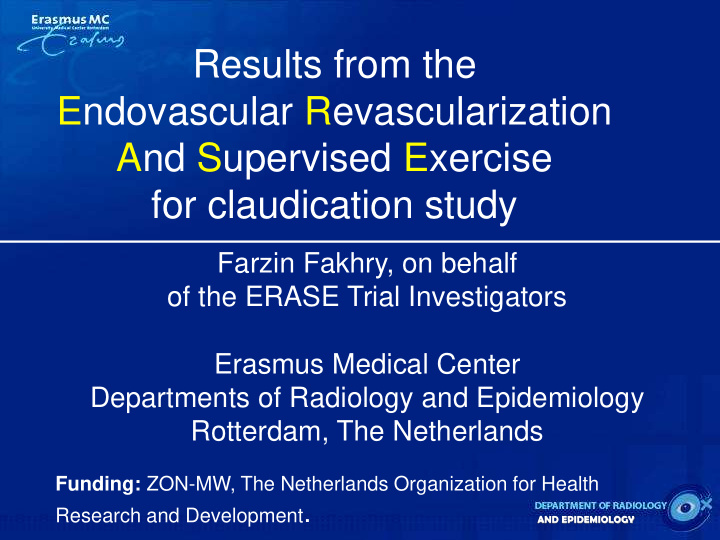



Results from the Endovascular Revascularization And Supervised Exercise for claudication study Farzin Fakhry, on behalf of the ERASE Trial Investigators Erasmus Medical Center Departments of Radiology and Epidemiology Rotterdam, The Netherlands Funding: ZON-MW, The Netherlands Organization for Health Research and Development . AND EPIDEMIOLOGY
Background Methods Results Conclusion • Intermittent claudication – Symptomatic form of peripheral arterial disease, 20-40 million cases worldwide • Functional- and quality of life limitations • Supervised exercise therapy first-line treatment, endovascular revascularization increasingly performed • Combination therapy of endovascular revascularization and exercise promising 2 AND EPIDEMIOLOGY
Background Methods Results Conclusion Study Objective ERASE Trial To compare the clinical effectiveness of Endovascular Revascularization (EVR) plus Supervised Exercise Therapy (SET) versus the standard care of SET only in patients with intermittent claudication. 3 3 AND EPIDEMIOLOGY
Background Methods Results Conclusion Study Population • Stable (>3 months) intermittent claudication • Vascular obstruction (> 50%) aortoiliac and/or femoropopliteal level • Target lesion suitable for endovascular revascularization • No limited ambulation due to any other condition • No prior treatment (including exercise therapy) 4 4 AND EPIDEMIOLOGY
Background Methods Results Conclusion Randomization EVR+SET SET (n=106) (n=106) Endovascular Revascularization • Balloon angioplasty aortoiliac and/or femoropopliteal lesion • Selective stenting Supervised Exercise Therapy • Approximately 1 hour sessions of exercise, trained physiotherapist • 2-3 s/wk 3 months, 1-2 s/wk 3-6 months and 1 s/4 wks 6- 12 months, depending on patients ’ progress and preference 5 AND EPIDEMIOLOGY
Background Methods Results Conclusion Outcome measures Primary Endpoint • Maximum walking distance, graded treadmill test (Gardner protocol, 30-min) Secondary Endpoints • Pain-free walking distance (Gardner protocol, 30-min) • Ankle brachial index at rest and post treadmill walking • Self-reported quality-of-life scores VascuQol, SF-36, Rating score and EuroQol • Leg amputations and secondary interventions 6 6 AND EPIDEMIOLOGY
Background Methods Results Conclusion Statistical analysis • Intention to treat principle • Tobit regression for walking distances • Mixed models for repeated measures • Kaplan Meier analysis • Level of significance: P ≤ 0.01 7 7 AND EPIDEMIOLOGY
Background Methods Results Conclusion Follow up • At 1, 6 and 12 months • Completeness of follow up: SET 92%; EVR+SET 94% • Deaths: SET 3; EVR+SET 1 Treatment compliance • SET: Average 43 sessions (71% > 26 sessions) • EVR+SET: 102 patients (96%) successful EVR, 63 patients (62%) stented • Average 30 sessions SET (44% >26 sessions) 8 8 AND EPIDEMIOLOGY
Background Methods Results Conclusion Baseline characteristics of the randomized patients SET EVR+SET (n= 106) (n= 106) 66 ( ± 10) 64 ( ± 9) Age (years) Gender (Male) 67% 58% Smoking (Current/Former) 92% 93% Hypertension 63% 60% Diabetes 26% 16% Dominant Lesion Aortoiliac 51% 55% Femoropopliteal 49% 45% 272 ( ± 124) 251 ( ± 117) Maximum Walking Distance (meters) 130 ( ± 77) 112 ( ± 68) Pain Free Walking Distance (meters) 4.5 ( ± 1.0) 4.5 ( ± 0.9) Vascular QoL score (1-7) 9 AND EPIDEMIOLOGY
Background Methods Results Conclusion AND EPIDEMIOLOGY
Background Methods Results Conclusion AND EPIDEMIOLOGY
Background Methods Results Conclusion AND EPIDEMIOLOGY
Background Methods Results Conclusion AND EPIDEMIOLOGY
Background Methods Results Conclusion AND EPIDEMIOLOGY
Background Methods Results Conclusion AND EPIDEMIOLOGY
Background Methods Results Conclusion Secondary interventions during follow up 16 16 AND EPIDEMIOLOGY
Background Methods Results Conclusion Summary • In patients with intermittent claudication a combination therapy of endovascular revascularization followed by supervised exercise therapy resulted in significant greater improvements in functional performance and quality-of-life compared to the standard care of supervised exercise therapy only. • Planned Cost-effectiveness analysis 17 17 AND EPIDEMIOLOGY
Background Methods Results Conclusion Centers and principal investigators • Amphia Hospital Breda, Lijckle van der Laan, MD, PhD • Bernhoven Hospital Oss, Taco Smits, MD, PhD • Catharina Hospital Eindhoven, Joep Teijink, MD, PhD • Elkerliek Hospital Helmond, Guido Stultiens, MD • Erasmus Medical Center Rotterdam, Farzin Fakhry, MSc, Sandra Spronk, PhD, Ellen Rouwet, MD, PhD and Myriam Hunink, MD, PhD • Haga Hospital The Hague, Jan Wever, MD, PhD • Ikazia Hospital Rotterdam, Ted den Hoed, MD, PhD • Reinier de Graaf Gasthuis Delft, Wolter Hoffmann, MD, PhD • Sint Fransiscus Gasthuis Rotterdam, Arie van der Ham, MD, PhD • Zorgsaam Hospital Terneuzen, Alex Derom, MD 18 18 AND EPIDEMIOLOGY
Recommend
More recommend